Pogonas or bearded dragons refer to agamid lizards that belong to the genus Pogonas, which has a total of 8 different species, all native to the varying habitats in Australia.
Among these species, the Pogona vitticeps (Inland or Central bearded dragon) is the most commonly kept as a pet. Some people also hold the Rankins dragon (Pogona henrylawsoni) and others.
Central bearded dragon colors
Naturally, Pogona vitticeps come varying colors, mainly brown, tan, or reddish-brown, with some hints of red or yellow commonly found on their head, which vary a little depending on their specific kind of their habitat or surroundings.
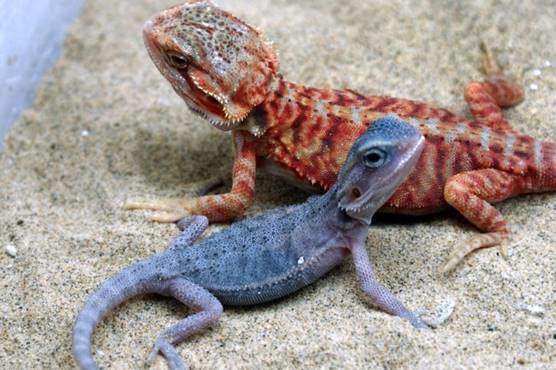
However, they can undergo slight skin color change when under light, darkness, or heat. Furthermore, these reptiles also change their color to camouflage (resemble surroundings) or do so to communicate with other lizards (2), among other reasons, including developing stress marks.
Understanding morphs – rare, fancy and cute beardies
While looking for a bearded dragon to buy, you may have heard about the term ‘fancy’ ‘rare’ ‘cute’ or ‘morphs’ among other names. Bearded dragon morphs are nothing other than versions of the inland bearded dragon created by professional breeders as well as some hobbyists through selective breeding.
On the other hand, fancy, cute, or rare are terms used to hype some unique looks just as you would say a ‘cute bearded dragon.’ You can get full young, juvenile, or adult fancy beardies but expect to spend more.
This selectively bred has created morphs with specific features, such as colorations, markings or patterns, nail color, head shape and sizes, body sizes, skin texture, scale, and spike appearance, among other traits.
Therefore, the term morphs describe more of how they look like as well as their size and not just their colors. Depending on their traits, some may be very expensive, especially the rare ones. Also, a pedigreed one will cost higher.
However, like normal beardies, morph bearded dragons have the following characteristics:
- They live for about 10-12 years under captivity
- They have the same dietary requirements, i.e., feeder insects, veggies, some safe plant, herbs, and fruit treats.
- They are laidback, hardy and low maintenance
- Live in the same similar habitat and beardie supplies. However, some may require slightly different habitat settings, especially humidity, UV light, and heat requirements, more so to those with fewer scales (a smoother skin).
- They grow up to standard size except for German giants.
Common terms
Before we look at the various beardie morphs, it is a good idea to familiarize ourselves with some words which we may use. They will ensure you understand the whole thing better, more so if you are a breeder.
1. Genes, alleles, and chromosome
Genes are units via which genetic materials pass from parents to offspring, and they are what controls various traits that progenies have.
An allele is a specific gene form that controls a particular trait, such as eye color. Usually, offspring inherit alleles from their parents, and these alleles are at specific genetic locus or position on chromosomes. An allele could be dominant or recessive.
Finally, chromosomes are present in a cell’s nucleus, and they are what carry genetic materials, and each has many genes.
2. Recessive, dominant and co-dominant traits
A trait that an individual animal has that doesn’t show is known to be recessive (mutant), while a dominant one, you will see it. Usually, the dominant feature masks the mutant one.
Finally, we say an animal has a co-dominant trait when an animal or person possesses two different genes without complete dominance.
3. Homozygosity
It refers to where an organism inherits the same traits from both parents, i.e., they have two identical alleles on both the homologous genes. For instance, a beardie could inherit hypomelanism from both parents, and this makes such an offspring homozygous.
4. ‘Het’(Heterozygous)
Heterozygosity occurs when an offspring inherits different traits from parents, with one being dominant and the other one being recessive (mutant).
Het or heterozygous means that the bearded dragon in question inherited a particular trait from their parent but didn’t show it, i.e., it is recessive. For instance, if this reptile has a translucent parent but not showing translucent trait, he is known as het translucent.
For example, a ‘translucent het hypomelanistic’ means that your pet shows a translucent trait but still has a hypomelanistic attribute that doesn’t show.
Such naming is crucial as it will show you the possibility of having an offspring with the specific trait in question, more so to breeders.
Sometimes, you will see percentages, and these are to help guess the likelihood that its offspring will have the specific trait, i.e., the guesstimate. The higher the score given, the higher the chance of getting that trait.
For instance, a 100% Het means one parent showed the specific trait, 50% Het means one parent was 100% Het if it ranges between 50 to 100%, both parts were Het to some percentage.
Finally, a double het means it has two recessive traits, such as translucent and hypomelanism traits that they don’t show.
5. Proven
When proven, it means the specific animal has passed the trait in question to its offspring via breeding it.
6. Leucism
Leucism refers to a trait where some animals produce very little melanin making them a little lighter than the others. For instance, some of the leucistic beardies include the hypos, zeros, and Witblits
Common bearded dragon morphs
When it comes to different morphs, there are many types broadly grouped according to their color, pattern, leucism, translucence, skin texture, size, and so on that are independent.
One beardie can have several of these traits. For instance, one could be translucent and have a tiger pattern or be a silkie and hypomelanistic.
Common types available in the market include the following:
1. Wild vs.regular, normal or standard beardie morphs
They look like those living in the wild in Australia. Their heads are triangular, have small spikes on their back, and they are available in various colors like brown, tan, red, or yellow with orange and black markings.
These are the most commonly available as well as the least expensive when it comes to buying or selling them.
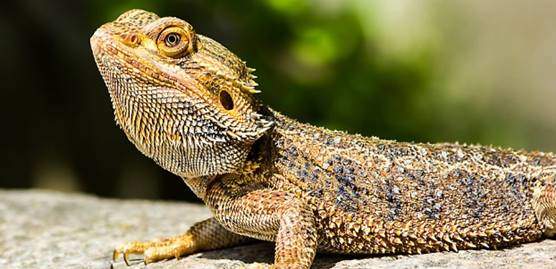
2. Hypomelanistic or hypo
The term hypomelanistic means not having enough melanin, and it describes beardies that have a lower color saturation, unlike standard morphs that have vivid colors, i.e., they are lighter in color.
They don’t produce dark colors or patterns, and their coloration looks more pastel-like with light brown see-through nails. However, they have small spikes on their backs, just as the standard beardies do.

Hypomelanistic doesn’t describe a particular color. Therefore, you can have different colors and traits that are hypomelanistic such as yellow, red, etc. Common morphs with this trait include:
- Blood hypo
- English Belgium hypo
- Red hypo
- Hypo red Crawley
- Hypo red bearded dragon
- Hypo het translucent
- Yellow hypo
- Hypo snow
- Blood hypo orange
- Zero hypo
Sometimes, you may also get vendors with red het hypo and hypo het translucent, meaning the first one does not show hypomelanism while the latter doesn’t show translucence.
3. Translucent (trans) and hypo trans
It is that describes the trait of having translucent scales and spikes (slightly opaque). You can almost see through them. Being translucent, you expect them to be a little hypomelanistic or have lighter colors.
Usually, trans look stronger and having bluish bellies and eyelids. Besides translucent scales and spikes, they have solid black or dark eyes with an invisible iris, a trait that makes them appealing and sought by many people.
However, their eye color may vary or change as they grow. Some breeders refer to those that don’t have solid dark or black eyes as partial trans.
Note that it is untrue that they are vulnerable to health issues, as there isn’t any substantial evidence to affirm these allegations.
If you go for hypo trans bearded dragons, this only indicates that both the translucent (trans) and hypomelanistic or hypos traits. Therefore, it means they have a muted color (have lighter color saturation) that is almost see-through or slightly transparent.
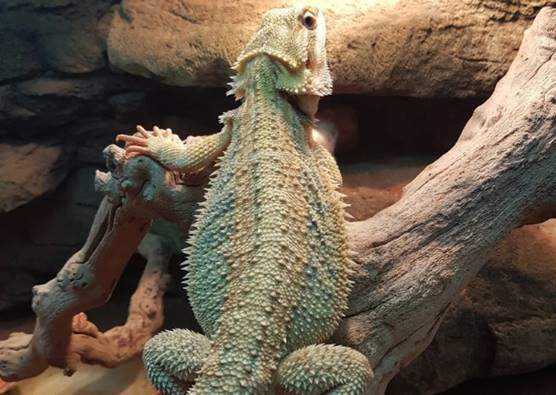
Some of the standard trans and hypo trans morphs you will get in the market include the following.
- Red hypo trans
- Red and orange hypo trans
- Hypo trans tiger
- Hypo translucent genetic stripe
- Leatherback with a genetic stripe
- Rally red trans
- Citrus tiger hypo translucent
- Dark translucent
- Polar translucent
- Belgium translucent
Unless indicated, the hypo het trans will appear hypo while the trans het hypo will appear translucent. You can’t tell they possess the recessive traits.
4. German giants
While they resemble standard beardies, the German giants are notably bigger. Furthermore, they are more aggressive, have smaller heads, and come in tans or browns with silvery-gold irises.
While still young, you may confuse with standard morphs. However, they can grow up to one and a half times larger than standard ones, i.e., the German giant bearded dragon size is about 30 inches long.
Common variations of the German giants include the greenie x orange German giant and hypo red dragon German giant
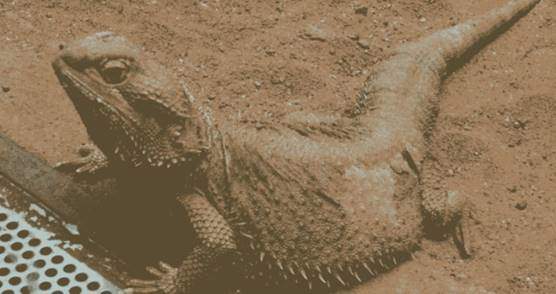
5. Leatherbacks including red, hypo or citrus
The most distinguishing feature of the leatherbacks is their smooth skin on their back that doesn’t have spikes, i.e., they have smaller scales making them soft. However, they do have spikes on the side of their body as well as on their head.
The absence of spikes on their back makes their coloration more vivid, a feature that attracts many. If you would like to buy them, expect to spend more since they are not easy to find (rare).

Since this is more about their back texture and nothing more, expect them to come in different colorations and have other features lie being hypo, translucent, and so on. Common ones include:
- Hypo leatherback
- Citrus leatherback
- Red leatherback
- Het hypo leatherback
- Purple paradox leatherback
- Hypo Translucent Leatherback Dunner
- Translucent Leatherback Dunner
- Tiger leatherback
- Red Italian leatherback
- Italian leatherback
- American leatherback
- Hypo zero leatherback
- Purple paradox leather back
- Citrus tangerine tiger leatherback
If you are looking for a leatherback, they are reasonably readily available. Their prices range from $150 to $250, and at Morphmarket.com, you will get the red hypo leatherback, white hypo leatherback, orange leatherback, hypo trans leatherback hypo citrus leatherback, and so on.
6. Microscale bearded dragons
Closely looks like the leatherbacks with fever spikes made from a heterozygous and homozygous leatherback. They also have fewer spikes on the side of their body, and those on the back of their head are smaller than usual without any on their beard or side of their body.

7. Silkbacks or silkie
Featuring a smooth or soft skin without spikes or scales and vibrate colors, the silkbacks are a morph of their kind and a real gem. However, before you quickly rush to spending a lot of money buying them, you deserve to know they need more care, including humidity and UV lighting, thanks to their delicate silky skin.
Also, their delicate skin requires you to house them separately in their tank or enclosure. Don’t accommodate these morphs with other beardies as they can quickly get injuries in case of fights due to hierarchical and dominant behaviors.
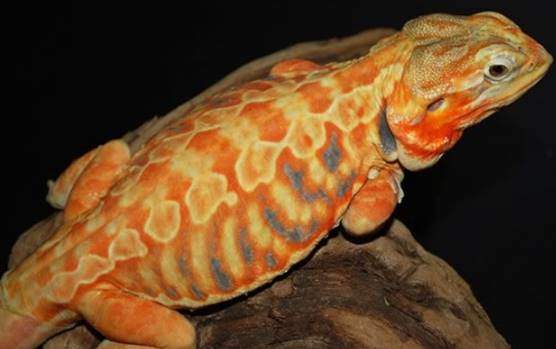
One good example is the red Italian silkback. However, many others come in various colors.
8. Silverback beardies
They were the first bearded dragons without patterns before zeros, Wero, and witblits. They may be brownish, beige or off-white and very rare to find. While young, they may show some patterns which diminish as they grow.
9. The Zeros, snows or whites (patternless)
They are the rarest type of bearded dragons. They don’t have any pattern and appear whitish, silvery, or smokey grey. They are due to genetic mutation (they have recessive genes that determine their coloration and pattern).
Some may be darker grey but will lighten when under darkness while others may have a slight purple tint.
A good example is the hypo zero bearded dragon, which is both hypomelanistic and has no patterns.
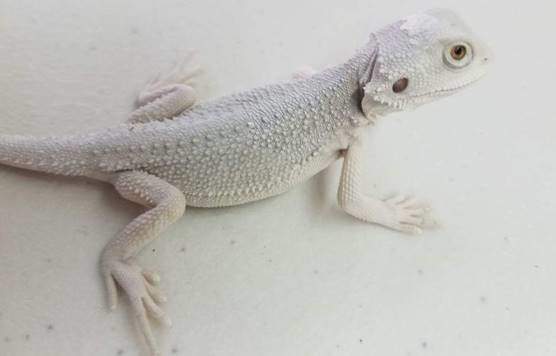
10. Witblits Morph
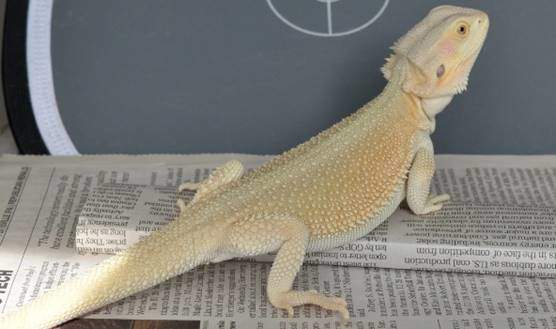
Unlike the Zero that doesn’t have color or pattern, they come in various solid colors but are way paler than the hypomelanistic morphs.
11. Wero morphs
Wero morphs are offsprings of zeros and witblits that look much like a zero except for the darker color blemishes as you near their tail.
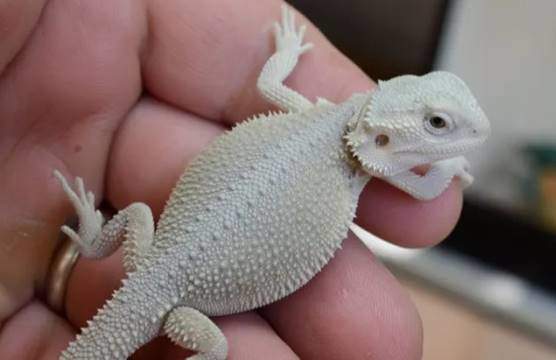
12. Tiger
These have markings or strip that resemble those of a tiger running across their body’s width. The bars running across their bark may be darker or lighter. Darker ones are expensive. Furthermore, you will get them in various colors, including citrus tiger, red tiger, and so on.
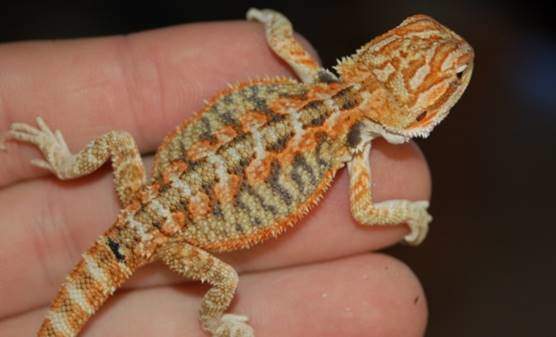
13. Genetic stripped
Unlike the tigers, these have a non-colored stripe running downwards towards their tail from their neck, i.e., along their body length and not across it.
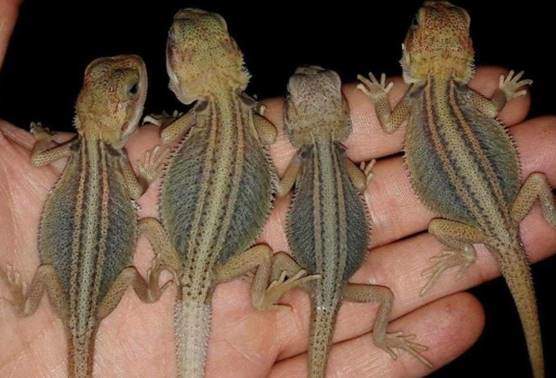
14. Dunner morphs
Named after the breeder who developed them, the Dunner morphs resembles the classic beardies except for their scales that don’t have a specific pattern. The scale patterns are asymmetrical and go in any direction, unlike classics whose are a little symmetrical.
What identifies the Dunner morphs are their scales and spots, which don’t form any specific pattern as well as the sideways instead of the downwards pointing neck spikes.
Behaviorally, some owners say while eating, they hold their food on their neck for a moment before swallowing it.

Since the Dunner beardies are more about the scale pattern and the other features we have mentioned, they can come in various colors, including solid colors with commonly available ones being:
- Hypo Dunner
- Yellow and orange hypo citrus Dunner
- Hypo trans leatherback Dunner
- Hypo translucent Dunner
- Red Dunner
15. Paradox bearded dragons like a purple paradox
These are cute looking beardies and one of the most sought for, making them very expensive. They have a random artistic patch, marking, or blotches that make them look like someone spilled paint on them.
Those with vibrant colors are very attractive, and the cause of their random patches is due to several gene mutations. Note that, while young, they don’t show their random pattern, but as they mature, they begin having this marking.
Paradox beardie morphs are very expensive, with some going for as high as $3000 to $5000 at Morphmarket.com. Other places to get them for sale include Spicedragons.com, Dachiubeardeddragons.com (have a purple paradox), Draggintails.net (Red citrus paradox), etcetera.
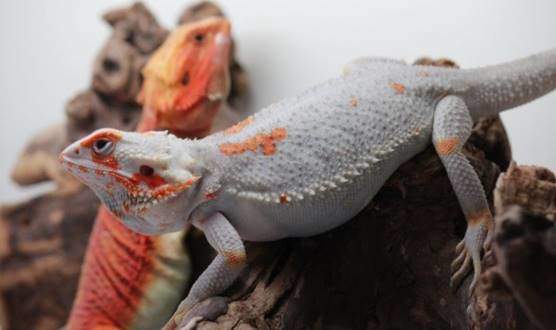
Bearded dragon colors
A specific color of a bearded dragon tells you more on the higher amount of coloring it has and not its texture, pattern, size, or whether it is translucent or not. This description tells you that other colors may be present. However, we are considering the primary or dominant color.
Secondly, we are not talking about when bearded dragons change color for several reasons. This color change is not permanent.
The trendy colors in the beardie morph market include the following:
1. Red
Besides red-colored bearded dragon, the blood-red and ruby red all fall in this category since their color inclines more to red than standard beardies. They are progenies of parents with higher red coloration making them appear redder than standard ones, and they are trendy in the market, and some may be super red.
If you need them, try the European red, Belgium x Blood, and other types. However, note that the red sand fire, sunburst, tangerine, orange, and citrus tiger may have different colors with a tinge of red. However, we prefer grouping them elsewhere.
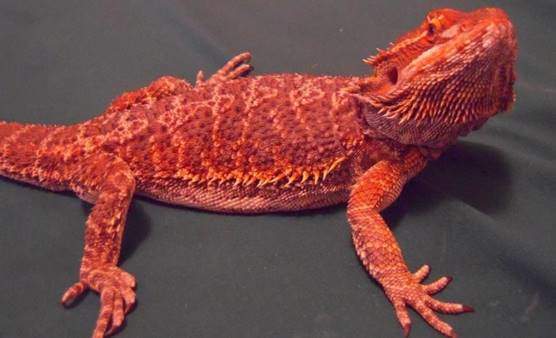
2. Orange and tangerine bearded dragons
Their coloration leans towards orange. Popular types that are orangish in color include orange, tangerine, and sunburst bearded dragon.
Tangerine bearded dragons are orange in color with some yellow touches. Some of the commonly available ones include hypo tangerine, double het dark tangerine going for $100-$300 at Morphmarket.com, or Atomiclizardranch.net.
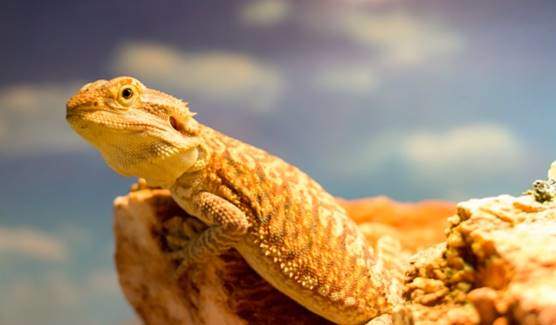
3. Tans and browns
Their colors are brown (darker or lighter, including tan, which is a pale shade of brown. The Sandy browns, muted tans, and beiges fall in this category.
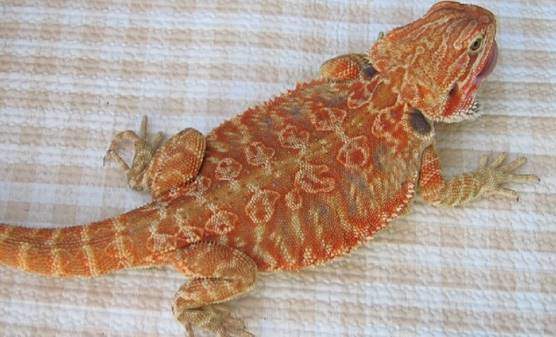
4. Yellow including sandfire and golden
These beardie morphs have yellow as their dominant color and may have other colors. Common ones include including citrus (bright yellow), sandfire, gold sandfire, lemon, and gold. The gold color is from breeding a red and yellow beardie.

5. Citrus including citrus tiger and hypo citrus
They are mainly bright deep yellow with a tinge of orange with the yellow appearance being more dominant. Sometimes, they are under the yellow coloration.
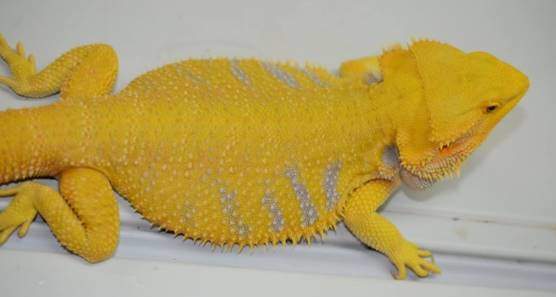
When it comes to buying them, they can be a little expensive, going for $200 onwards. Some of the types available for sale include:
- Citrus bearded dragon
- Hypo citrus
- Hypo citrus leatherback Dunner
- Hypo citrus Dunner
- Red Citrus Hypo Het Trans
- Citrus het trans
- Yellow hypo citrus
- Red citrus leatherback
- Citrus tiger
You can find them at Morphmarket.com, Carolinaclassicdragons.com, Dachiubeardeddragons.com, Atomic Lizard Ranch, Cbreptile.com, and so on.
6. Silvery, pale, white or all white
These are the ones that show leucism and may appear white, silver, pale gray, or off-white. They include the snow.
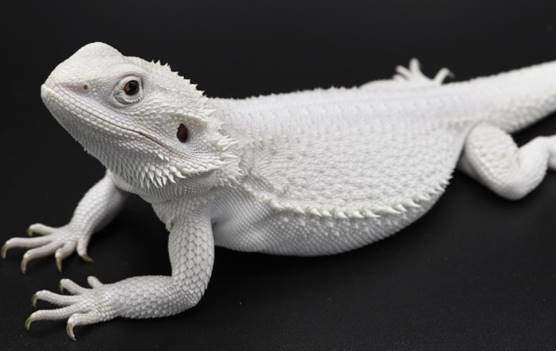
7. Albino bearded dragons
These are due to genetic mutation, and they lack pigmentation both on their skin, nails, and eyes. Albinism occurs due to recessive alleles inherited from both parents and not just one. Unlike leucism, where melanin much less, in albino, there is no melanin at all.
8. Purple and blue and blue flame
They are very rare, may not retain the color perfectly well as they grow. They have purplish or blue coloration.
The blue flame bearded dragon has a bright blue color on its sides, making it resemble a flame, making them a rare type.
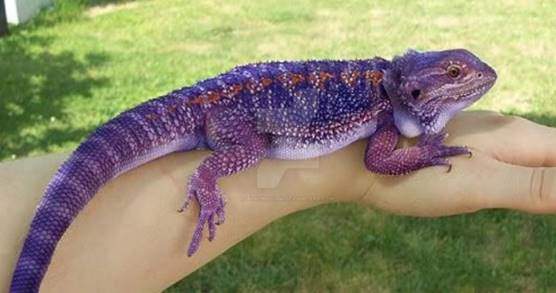
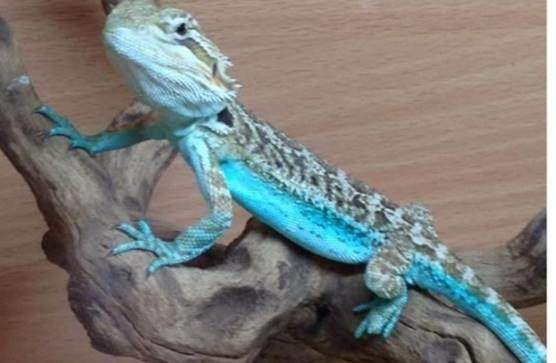
Other colors like pastel
- Pastel & Leucistic X Yellow Red Desert Bearded Dragon
- Coral and red coral
Besides what we have colored, you may get other features while looking at some available at Fire and Ice Dragons, Sandfiredragonranch.com, Morphmarket.com, Atomic Lizard Ranch, Cbreptile.com and so on.
